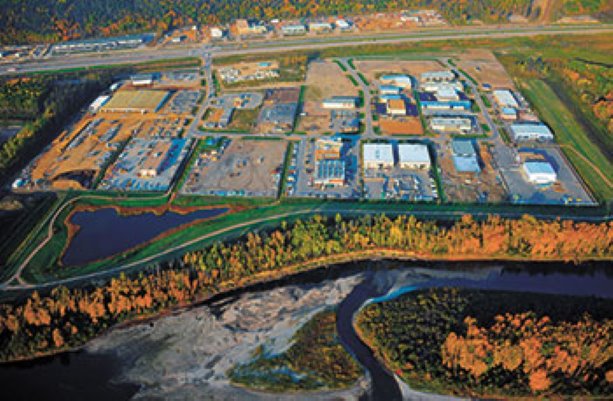Just because Fort McMurray, Alta. and its home municipality of Wood Buffalo house the Athabasca oilsands, considered the largest industrial project in the world, doesn’t mean principles like sustainability get lost in translation.
Take the TaigaNova Eco-industrial Park as an example.
As Canada’s first conventionally financed eco-industrial park (EIP), it is described as a highly efficient EIP that uses green infrastructure and innovative sustainable design approaches resulting in a higher quality industrial development.
The roughly 23-hectare site has 27 lots — four zoned as highway commercial and 23 as business industrial, ranging in size from 0.34 ha to 1.97 ha — and sits on the north edge of Fort McMurray.
Construction on the site began in 2009.
All lots have been sold and are in various stages with some fully built out and occupied, others still under construction, while construction has yet to begin in others.
Taiga is from a Mongolian word meaning boreal forest, a feature that stretches across much of the Athabasca oilsands.
Nova is Latin for “new”, but can also mean novel and stellar.
TaigaNova was developed by Wood Buffalo Housing & Development Corp. (WBH&DC) as an eco-industrial park meaning it has more efficient buildings and infrastructure, will preserve green areas and encourages businesses to function as a community.
As such, this EIP will have much less environmental impact than a conventional industrial park.
“This is a unique development in the region that is known for its perceived environmental issues,” said Bryan Lutes, WBH&DC president.
“At the time of completion, on top of the environmental successes, this was the only financially successful eco-park in North America.”
The serviced lots were sold to private businesses, creating revenue for WBH&DC, which retained one of the lots.
The money gained from this development will be used to support its mandate of creating affordable housing for the residents of the Regional Municipality of Wood Buffalo.
Two of the EIP’s four primary objectives focus on green issues.
They take a leadership role in sustainable industrial development and minimize environmental impacts and enhance quality of life.
The remaining priorities are to address a shortage of industrial land in the area and to support the business needs of the resource sector as well as the local economy.
A couple of green features of TaigaNova focus on storm water. Alternative storm water management includes a storm pond that is designed as both an amenity and habitat, and a new hybrid road cross section that allows for alternative storm water management.
The development is considered in-town.
“(Regional planners) wanted us to do a normal cross-section of road with curbs, gutters and sidewalks. We convinced them we didn’t want to do that. We wanted to put in ditches,” said Lutes.
“Engineers call them drainage swales, to drain the storm water from the roads into these swales that came down through to the settling pond and then eventually to the river.”
The pond is on the eastern boundary of the development.
Going concrete-free in the ditches streamlines the ‘filtering’ process and letting Mother Nature take over encourages the growth of natural vegetation such as rushes.
“They have very low grades or slopes. Normally they’d be two or three per cent. We’ve kept them to one or less per cent so the water slowly flows through the ditches and meanders and filters itself out before it gets to the pond,” explained Lutes.
The system is functioning as it was designed.
It can handle large amounts of water as demonstrated last June when the area was hit with major rainfall that resulted in flooding in lower lying areas of Fort McMurray. Taking the natural approach to the storm water management has also encouraged wildlife into the park.
“There are lots in there. There’s ducks and geese that land there. There’s deer that wander up from the forest,” he said.
“I’ve seen more wildlife around that pond than anywhere else here.”
Structures in the park must be 25 per cent more efficient than the Model National Energy Code, and they must encourage environmental sustainability through the use of permeable paving materials, which also must be recycled.
Energy efficient vehicles such as hybrids and vehicles used for car pooling are allotted preferential parking.
Future pavements will be thinner than usual roadways though still able to handle larger vehicles accessing the EIP.
Also, the walking trail around the development has been equipped with solar lights that even work at 40 below. Some businesses, such as the Athabasca Chipewyan First Nation, have built LEED certified buildings.



Recent Comments
comments for this post are closed